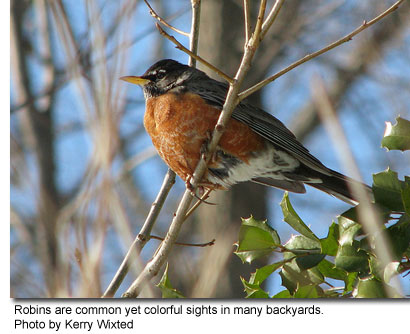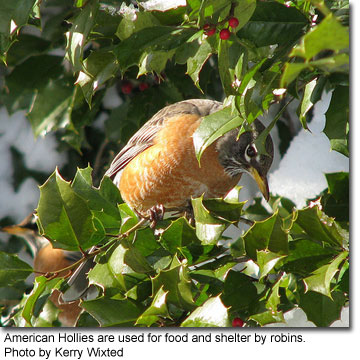Practically everyone who lives in Maryland has seen a robin. Its characteristic red breast, so bright against its brown-gray and white body, is familiar to many. Male and female robins look very much alike. However, if you look carefully, you'll be able to see that male robins are slightly larger than females and have darker gray feathers on their heads.

Natural History
Robins are found almost anywhere in the United States. Robins that nest in Canada will often migrate to the United States in the winter while some robins spend their winters in Mexico. Most, however, remain in one area all year long. If you don't see your resident robins in the winter, then it's probably because they are living in the woods where they can find food and shelter from the harsh winter weather.
Robins live in two different kinds of environments. In the spring, these birds move to their traditional nesting territories. These are usually in park-like areas with lots of big shade trees and fields with short grass. Shade trees, and sometimes shrubs, are used to shelter their nests. Grassy fields, filled with worms and other grubs, provide a perfect food source for the robins and their growing young. In winter, robins cannot find insects, so they rely on plants that produce fruit late in the year. Therefore, many robins retreat to wooded areas in the winter, making it seem like they migrated. During this time, fruits become a staple of robin diets. Interestingly enough, robins which almost exclusively consume honeysuckle berries at this time will sometimes get intoxicated!
Robins begin nesting in April. Females are in charge of nest site selection as well as nest construction. The female robins will build cup-shaped nests that are reinforced with soft mud and lined with dry grasses. On average, robins lay three to four bright blue eggs. After about two weeks, the eggs hatch, delivering blind and featherless young into the world. The chicks totally depend on their parents for food and warmth. In another two weeks or so, the young birds will be fully feathered and will begin to try to fly out of the nest.
Should You Rescue That Baby Robin?
Often, young robins fly out of the nest before they are able to fly back! Their parents will continue to feed them and they will get the strength they need to fly back within a day or two. Should you find a young bird in your yard that appears abandoned, think twice before "rescuing" it. If you can find and reach the nest, then it's okay to put the bird back. Its parents will not abandon it. It is myth that birds will abandon their young because of human smell. Robins and most other birds have a very poor sense of smell. If you can't find or reach the nest, then check the health of the bird. A baby bird that is completely covered with feathers and can hop away from you does not need your help. It is much better off in the wild than it will be in your house. Sometimes other animals eat these young birds. This is a natural process and is in no way unusual or cruel. Often, humans "rescuing" baby birds cause them to suffer much more than if they had been left where found.

How to Attract Robins
If you have a lawn, then they will come! Robins prefer open ground, such as suburban lawns, on which to forage for food, and some woods or at least a few scattered trees and shrubs for nesting and roosting. They are most often seen searching for earthworms in backyard lawns. Robins also eat insects including caterpillars, grasshoppers and beetle grubs. In your backyard, set aside a damp or grassy area for them so that they have a place to find earthworms and insects. It is important to keep the area pesticide free, so that the bugs will not be killed off and residual toxins will not affect robins and other foraging birds. You can also build a
brush pile or maintain a pile of leaves in your yard, which will help attract worms and insects for them to forage on.
Although robins are typically seen searching for earthworms, over half of their diet in summer, fall and winter is made up of fruits and berries such as bayberry, elderberry, grape, crabapple and holly. Planting fruiting varieties such as cherry, dogwood, sumac, Virginia creeper and blackberry will help attract robins to your backyard throughout the year. Robins will also eat the fruits of hollies, mulberry, apple, pokeweed, blueberry, serviceberry, greenbrier, elderberry, viburnum, hawthorn, hackberry and spicebush.
Robins are not frequent visitors to feeders, but when they do come, they like fresh fruit. Apples, grapes and cherries, suet and peanuts offered in a platform type feeder are among their favorite foods.

Just Add Water!
Robins not only need to drink, but also they love to bathe often. To help the robins that stay in your area, a birdbath is one of the best items to have during both the summer and winter months.
In the spring, robins construct a nest, which the female lines with mud. During the mating season, beginning in April, provide a source of mud for them to use to build their nests. You can accomplish this by taking an old trash can lid and filling it up with water and dirt.
Nesting Platform
Robins readily nest near humans. For example, they commonly nest on top of downspouts, windowsills, doors and lights. To entice them to nest in other areas, you can create a special robin-nesting platform which provides firm support and overhead protection from rain. You can build a nesting platform for your backyard robins as it's easy to do. When the birds use it, the platform will help the robin's nest survive strong winds and summer thunderstorms.
How to Build a Robin Nesting Platform
Materials
- 1"x 10" x 4' untreated lumber
- 1" nails
Construction
- Mark and cut the pieces out of lumber as shown. Assemble.
- Place it on a sheltered window ledge or about 6 to 10 feet above the ground on the trunk of a tree. Be sure to place the box in an area with little human traffic as nesting robins can be territorial around their nests. Don’t place the nest over top a hard surface like concrete because fledglings may get injured when they leave the nest.
- Be sure to remove old nesting material each fall so that the robins can build a new nest the following year. Clean and disinfect the shelves before putting them out again in the spring.

Robin Nesting Platform Design Adapted from Minnesota DNR
Invite Wildlife to Your Backyard!
For more information, please contact:
Maryland Department of Natural Resources
Wildlife and Heritage Service
Tawes State Office Building, E-1
Annapolis MD 21401
410-260-8540
Toll-free in Maryland: 1-877-620-8DNR
[email protected]
Acknowledgements:
- Robins sitting in tree, photo by Kerry Wixted
- Fledgling robin, photo by Lin and Dan Dzurisin
- Robin in American Holly, photo by Kerry Wixted
- Illustration of Robin Nesting Platform, design adapted from Minnesota DNR